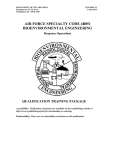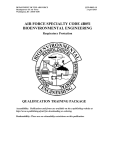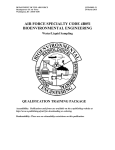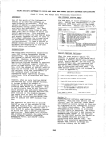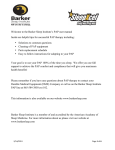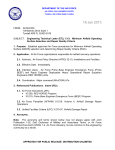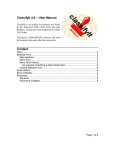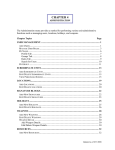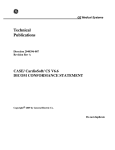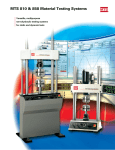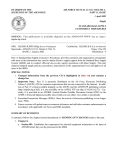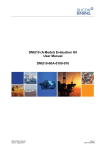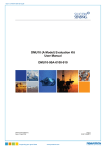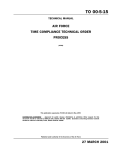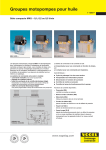Download Response Operations
Transcript
DEPARTMENT OF THE AIR FORCE Headquarters US Air Force Washington, DC 20330-1030 QTP 4B071-18 3 April 2015 AIR FORCE SPECIALTY CODE 4B071 BIOENVIRONMENTAL ENGINEERING Response Operations QUALIFICATION TRAINING PACKAGE Accessibility: Publications and forms are available on the e-publishing website at http://www.e-publishing.af.mil for downloading or ordering. Realeasability: There are no releasability restrictions on this publication. AFQTP 4B071-18 Craftsman Training Guide: Response Operations Table of Contents STS Line Item 5.2.2: Input and interpret risk assessment tools / dispersion models (i.e. CHEMRAT, CHART or equivalent) ................................................................................................................................................................................... 1 TRAINER GUIDANCE ........................................................................................................................................................... 1 TASK STEPS ........................................................................................................................................................................... 2 TRAINEE REVIEW QUESTIONS .......................................................................................................................................... 4 PERFORMANCE CHECKLIST .............................................................................................................................................. 6 ANSWERS ............................................................................................................................................................................... 8 STS Line Item 5.2.4: Develop emergency management response plans and checklists ..................................................... 10 TRAINER GUIDANCE ......................................................................................................................................................... 10 TASK STEPS ......................................................................................................................................................................... 11 TRAINEE REVIEW QUESTIONS ........................................................................................................................................ 12 PERFORMANCE CHECKLIST ............................................................................................................................................ 13 ANSWERS ............................................................................................................................................................................. 14 AFQTP 4B071-18 Craftsman Training Guide: Response Operations STS Line Item 5.2.2: Input and interpret risk assessment tools / dispersion models (i.e. CHEMRAT, CHART or equivalent) TRAINER GUIDANCE Proficiency Code: 3c PC Definition: Can do all parts of the task. Needs only a spot check of completed work. Can identify why and when the task must be done and why each step is needed. Prerequisites: None Training References: Chemical Hazard Estimation Method and Risk Assessment Tool (CHEMRAT), Phase One User’s Manual, 2003. https://hpws.afrl.af.mil/dhp/OE/ESOHSC/pages/index.cfm?id=680&admin Chemical, Biological, Radiological, and Nuclear (CBRN) Health Assessment and Risk Tool (CHART) User Guide, 2007. https://hpws.afrl.af.mil/dhp/OE/ESOHSC/pages/index.cfm?id=680&admin Additional Supporting References: None CDC Reference: 4B051 Training Support Material: Specific Techniques: Criterion Objective: After Action Report for Chemical Release or Exercise Scenario CHEMRAT and CHART computer program Conduct hands-on training and evaluation of interpretation of air sampling results to compare with applicable standard. Given a scenario, input hazards into a risk assessment tool, interpret the results, and communicate the health risk assessment data successfully completing all checklist items with NO trainer assistance. Notes: The CHART program and its companion, the Chemical Hazard Estimation Method and Risk Assessment Tool (CHEMRAT), are very useful references for assessing hazards and estimating hazard duration during CBRN incidents, particularly chemical warfare agent attacks. These tools are available at the USAFSAM ESOH Service Center website. AFQTP 4B071-18 Craftsman Training Guide: Response Operations TASK STEPS Input and Interpret Data in CHART: 1. Select the agent of concern from the drop-down list in STEP 1 within CHART. 2. Input temperature data in STEP 2.1 3. Input exposure concentration in STEP 3.2 4. Select the appropriate detection limit in STEP 3a.3 5. Input estimated exposure duration in STEP 4.4 6. Click “Calculate Risk” button to generate Chemical Health Risk Assessment Data. 7. Interpret risk assessment data using CHART User Guide. 8. Communicate health risk assessment data to appropriate decision makers/CCs/potentially affected members. Input and Interpret Data in CHEMRAT: 1. Select agent of concern from the drop-down list in CHEMRAT.5 2. Select whether the agent is viscosity (“Neat” or “Thickened”)6 based on intel from drop down list. 3. Determine the type of weapon system (i.e. TBM Air, TBM Ground, or a specific TBM that may target the operating area).7 4. Select the estimated number of in-bound TBMs or TBMs causing agent deposition. 5. Select appropriate target area.8 6. Input the appropriate surface (i.e. asphalt, concrete, or sand). 7. Obtain temperature, wind and stability, using appropriate conversions.9 8. Area coverage – set to “Peak.”10 9. Set exposure duration initially to 1 hour (matches persistency table).11 10. Select protection level.12 11. Interpret risk assessment data using Chemical Hazard Estimation Method and Risk Assessment Tool (CHEMRAT) user’s manual and Hazard Duration Estimate Using CHEMRAT checklist.13 12. Communicate health risk assessment data to appropriate decision makers/CCs/potentially affected members. LOCAL REQUIREMENTS: Develop scenario with exercise inputs for CHEMRAT/CHART tools. NOTES: 1. The default temperature unit of measure is Fahrenheit. This is indicated by a check in the box labeled “Check for Degrees F.” Selected agents have toxicity estimates for Percutaneous Vapor exposure under hot and moderate temperatures. Hot temperatures are defined as greater than 85 degrees F. Moderate temperatures are defined as 65 to 85 degrees F. In general, as the temperature increases, the effective Percutaneous Vapor dosage decreases. CHART will use the temperature input to determine the appropriate toxicity values to calculate and display. 2. Determining the concentration of a particular chemical warfare agent in the environment is limited by the equipment technologies employed. The default unit of measure is milligrams per cubic meter. If parts per million (ppm) are to be used, indicate by a check in the box labeled “Check for ppm Units.” There are several methods of determining the concentration, to include a measured concentration; a concentration equal to the detection limit of a particular piece of equipment; and a concentration generated from a CHEMRAT prediction. AFQTP 4B071-18 Craftsman Training Guide: Response Operations 3. CHART is populated with detection limits for various equipment and operating modes. These detection limits are known for the agent selected in Step 1. To use this section, select the Equipment/Method by placing the cursor over the applicable equipment and clicking the left mouse button. The Published Detection Limit for Selected Agent value will appear in the right hand column. 4. This is the anticipated time for an unprotected airman to accomplish a task that demands a reduction in the MOPP level. The unit of measure is minutes for all inputs. 5. Select the agent(s) used in the attack. Possible choices are: “GB&GF”, “GD”, “GF”, “HD”, and “VX”. If multiple agents are used, examine each case and result separately. For “GB&GF”, CHEMRAT assumes the tactical ballistic missile (TBM) carries both agents. 6. Possible chemical choices are: “GB&GF”, “GD”, “GF”, “HD”, and “VX”. If multiple agents are used, examine each case and result separately. For “GB&GF”, CHEMRAT assumes the tactical ballistic missile (TBM) carries both agents. 7. Number of weapons default = 1 unless you receive specific reports of multiple explosions in same sector. 8. From this menu, the user can select an area size or a specific air base. This version of CHEMRAT contains two specific air bases, listed as AB1 and AB2, and two generalized base sizes: small and large. A separate Appendix C contains the identification key that ties specific weapon systems to specific air bases. 9. Small base = 3 km (downwind) × 1 km (crosswind) Large base = 5 km (downwind) × 3 km (crosswind) HINT – Always choose “SMALL The choices are 10 °C (50 °F), 20°C (68 °F), 30 °C (86 °F), and 40 °C (104 °F). If the area temperature falls between two temperature ranges, evaluate both temperatures and compare the results. Select the temperature that presents the worst-case results. Select the wind speed closest to forecast or actual conditions. If the current wind speed falls between two wind speed ranges, evaluate both wind speeds and compare the results. Select the wind speed that presents the worstcase results. Wind Speed and Stability Categories Wind Speed Stability Category 1 m/s (3.6 km/h) F (Stable) 3 m/s (10.8 km/h) D or F 5 m/s (18.0 km/h) D (Neutral) 10. This represents the concentration in the grid receiving the most contamination. Use 99 and 95 if you have the time, but if the results are more than 10x lower than peak, use peak for all VLS-Track plume area. (reference: pp 19-20 of policy letter and page 17 of CHEMRAT guidance for background). 11. For subsequent attacks, consider lengthening exposure time to estimate total length of exposure (if people will be in both places). Or, if performing risk assessment for a particular task, enter the expected duration of that task (for example, sortie generation will take 2 hours). 12. To estimate inhaled exposure risk if MOPP reduced to MOPP 0-2, select “Inhaled” and “None.” To estimate percutaneous risk, select “PercVapor” and “None.” For G series agents, the percutaneous vapor penetration is relatively low (90% inhalations vs. 10% dermal). VX, however, is 50% inhaled and 50% dermal. 13. CHEMRAT User’s Manual and Checklist and Hazard Duration Estimate Using CHEMRAT checklist are located at the following link - https://hpws.afrl.af.mil/dhp/OE/ESOHSC/pages/index.cfm?id=680&admin AFQTP 4B071-18 Craftsman Training Guide: Response Operations TRAINEE REVIEW QUESTIONS STS Line Item 5.2.2: Input and interpret risk assessment tools / dispersion models (i.e. CHEMRAT, CHART or equivalent) 1. Given the information following below, what is your health risk assessment from CHART? Agent – GA Temp – 95 degrees F Concentration – 2 mg/m3 Exposure Time – 20 minutes 2. Given the information following below, what is your health risk assessment from CHART? Agent – GD Viscosity – Neat Weapon System – TBM Air # Weapons – 1 Target Area – Small Surface – Asphalt Temp – 10C Wind – 1 m/s Stability - F Exposure Type – Inhaled Exposure Duration – 2 Hours Protection – NONE Area Coverage - 99th 3. Why is inputting temperature into CHART important? AFQTP 4B071-18 Craftsman Training Guide: Response Operations 4. Risk percentages outside the + or – 1 standard deviation have limited accuracy. The risk level then should be adjusted between the ___ and ____ percentile. 5. Personnel working on the flight line for 5 hours in MOPP 2 have a high possibility of receiving a lethal dose through inhalation. What can be done to lower this risk to workers? AFQTP 4B071-18 Craftsman Training Guide: Response Operations PERFORMANCE CHECKLIST STS Line Item 5.2.2: Input and interpret risk assessment tools / dispersion models (i.e. CHEMRAT, CHART or equivalent) Proficiency Code: 3c PC Definition: Can do all parts of the task. Needs only a spot check of completed work. Can identify why and when the task must be done and why each step is needed. DID THE TRAINEE… INPUT AND INTERPRET DATA IN CHART 1. Select the agent of concern from the drop-down list in STEP 1 within CHART? 2. Input temperature data in STEP 2? 3. Input exposure concentration in STEP 3? 4. Select the appropriate detection limit in STEP 3a? 5. Input estimated exposure duration in STEP 4? 6. Click “Calculate Risk” button to generate Chemical Health Risk Assessment Data? 7. Interpret risk assessment data using CHART User Guide? 8. Communicate health risk assessment data to appropriate decision makers/CCs/potentially affected members? INPUT AND INTERPRET DATA IN CHEMRAT 1. Select agent of concern from the drop-down list in CHEMRAT? 2. Select whether the agent is viscosity (“Neat” or “Thickened”) based on intel from drop down list? 3. Determine the type of weapon system (i.e. TBM Air, TBM Ground, or a specific TBM that may target the operating area)? 4. Select the estimated number of in-bound TBMs or TBMs causing agent deposition? 5. Select appropriate target area? 6. Input the appropriate surface (i.e. asphalt, concrete, or sand)? 7. Obtain temperature, wind and stability, using appropriate conversions? 8. Area coverage – set to “Peak”? YES NO AFQTP 4B071-18 Craftsman Training Guide: Response Operations 9. Set exposure duration initially to 1 hour (matches persistency table)? 10. Select protection level? 11. Interpret risk assessment data using Chemical Hazard Estimation Method and Risk Assessment Tool (CHEMRAT) user’s manual and Hazard Duration Estimate Using CHEMRAT checklist? 12. Communicate health risk assessment data to appropriate decision makers/CCs/potentially affected members? Did the trainee successfully complete the tasks? TRAINEE NAME (PRINT) TRAINER NAME (PRINT) AFQTP 4B071-18 Craftsman Training Guide: Response Operations ANSWERS 1. Given the information following below, what is your health risk assessment from CHART? Agent – GA Temp – 95 degrees F Concentration – 2 mg/m3 Exposure Time – 20 minutes Answers are subjective: (Example below) Based off of available data, leadership can expect >84% of the unprotected exposed population to exhibit some type of Threshold Effects (e.g., miosis, rhinorrhea, tightness in one’s chest). The degree of symptoms are directly related to the work level (i.e. in other words it takes a smaller dose at a higher work level to exhibit the same effects at a higher dose at a lower work level). Continued exposures above these levels, with increased workloads, will lead to nausea, vomiting, then seizures and even the increase in fatalities if controls are not implemented (i.e. MOPP levels, split MOPP and etc.) Depending on type of mission and military necessity, sheltering-in-place may be another option. (Source: 4B051 CDC and Chemical, Biological, Radiological, and Nuclear (CBRN) Health Assessment and Risk Tool (CHART) User Guide) 2. Given the information following below, what is your health risk assessment from CHART? Agent – GD Viscosity – Neat Weapon System – TBM Air # Weapons – 1 Target Area – Small Surface – Asphalt Temp – 10C Wind – 1 m/s Stability - F Exposure Type – Inhaled Exposure Duration – 2 Hours Protection – NONE Area Coverage - 99th Answers are subjective: (Example below) Based off of available data in the area of concern (AOC) Lethal Concentrations/Effects (i.e. death) can be expected up to 2.5 hours after initial attack, dropping to Incapacitating Effects (i.e. convulsions) between 2.5 to 3 hours after attack, down to Threshold Effects 3 to 4.5 hours after attack. Sheltering-in-place and/or MOPP levels should be implemented. Commanders should weigh criticality of mission with expected outcomes from exposing personnel to higher levels immediately after an attack. (Source: Chemical Hazard Estimation Method and Risk Assessment Tool (CHEMRAT), Phase One User’s Manual, 2003, AFRL, page 19) AFQTP 4B071-18 Craftsman Training Guide: Response Operations 3. Why is inputting temperature into CHART important? A: As the temperature increases, the effective Percutaneous Vapor dosage decreases. CHART will use the temperature input to determine the appropriate toxicity values to calculate and display. (Source: Chemical, Biological, Radiological, and Nuclear (CBRN) Health Assessment and Risk Tool (CHART) User Guide, 2007, pg. 4.) 4. Risk percentages outside the + or – 1 standard deviation have limited accuracy. The risk level then should be adjusted between the ______ and ______ percentile. A: 16th and 84th (Source: Chemical Hazard Estimation Method and Risk Assessment Tool (CHEMRAT), Phase One User’s Manual, 2003, AFRL, para 3.2.1.5.) 5. Personnel working on the flight line for 5 hours in MOPP 2 have a high possibility of receiving a lethal dose through inhalation. What can be done to lower this risk to workers? A: Decrease the amount of work time and increase MOPP level (Source: Chemical Hazard Estimation Method and Risk Assessment Tool (CHEMRAT), Phase One User’s Manual, 2003, AFRL, para 3.2.1.2, 3.2.1.3) AFQTP 4B071-18 Craftsman Training Guide: Response Operations STS Line Item 5.2.4: Develop emergency management response plans and checklists TRAINER GUIDANCE Proficiency Code: 3c PC Definition: Can do all parts of the task. Needs only a spot check of completed work. Can identify why and when the task must be done and why each step is needed. Prerequisites: None Training References: Additional Supporting References: AFI 41-106, Medical Readiness Program Management, 22 April 2014. AFMAN 10-2502, Air Force Incident Management System (AFIMS) Standards and Procedures, September 2011. AFI 10-2501, Air Force Emergency Management Program Planning and Operations, 24 January 2007. Corrected 10 May 2013. AFMAN 10-2504, Air Force Incident Management Guidance for Major Accidents and Natural Disasters, 13 May 2013. Installation Emergency Management Plan (IEMP), Locally Developed. Medical Contingency Response Plan (MCRP), Annex F, Locally developed. Locally developed BE checklists referenced in MCRP. BE Field Manual AFDD 3-40, Counter-Chemical, Biological, Radiological and Nuclear Operations, 26 January 2007. Last Review 1 November 2011. AFTTP 3-42.32, Home Station Medical Response to Chemical, Biological, Radiological, and Nuclear Incidents, 2013. CDC Reference: 4B051 Training Support Material: Exercise Scenario BE Response Checklist Specific Techniques: Criterion Objective: Conduct hands-on training and evaluation on development of emergency management plans and checklists With proper resources, develop a comprehensive response checklist/plan for a potential threat successfully completing all checklist items with NO trainer assistance. Notes: All units must develop contingency plans and conduct training and exercises for both their home station and their deployment location. They must develop plans, training, contingency response checklists and exercises based upon a realistic threat and assessment of resources that will be available in a contingency. AFQTP 4B071-18 Craftsman Training Guide: Response Operations TASK STEPS 1. Determine the need for a specific checklist/plan based on local emergency management response plans (i.e. IEMP 10-2, MCRP, and WCRP), intelligence products, occupational and environmental health surveillance data (i.e. Conceptual Site Model from OEHSA), TIC/TIM Vulnerability Assessments, and Water Vulnerability Assessments. 2. Where applicable, review knowledge exchange and ESOH Service Center websites for specific checklist(s)/plan(s) that are already created that may suite the installation’s need. 3. Gather appropriate resources and references (i.e. ERG, NIOSH Pocket Guide, BE Field Manual) to support checklist/plan development. 4. Identify the detailed steps/line items that need to be accomplished for each hazard identified in Step 1. 5. Determine what resources are required (e.g. manning, equipment, vehicles) and ensure they are referenced within the appropriate checklist(s)/plan(s). 6. Once information is compiled, lay out step-by-step instructions/line items in an approved checklist/plan format by the local installation. Keep in mind that checklist(s)/plan(s) must tell who, what, when, where and how actions will be accomplished. 7. Determine if checklists will need to be cross-referenced/fed into other checklist(s)/plan(s) (i.e. water main break checklist used in conjunction with bacte/chlorine/pH monitoring checklist). 8. Validate that information shared between multiple checklists/plans are valid/current. 9. Initiate a peer-review of the checklist(s)/plan(s) through appropriate channels. 10. Properly execute checklist(s)/plan(s) requirements/line items as required. 11. After exercising draft checklist(s)/plan(s), update as needed. 12. Ensure checklist/plan is included/referenced in higher level plans where needed (i.e. MCRP, IEMP). LOCAL REQUIREMENTS: See Notes above NOTES: None AFQTP 4B071-18 Craftsman Training Guide: Response Operations TRAINEE REVIEW QUESTIONS STS Line Item 5.2.4: Develop emergency management response plans and checklists 1. When developing a checklist, what plan can be referenced that outlines BE responsibilities? 2. The MCRP is designed to support what? 3. When developing a checklist why is it important to not to develop a checklist that is length, complex, and overly complicated? 4. Why are checklists important to have during emergency responses? AFQTP 4B071-18 Craftsman Training Guide: Response Operations PERFORMANCE CHECKLIST STS Line Item 5.2.4: Develop emergency management response plans and checklists Proficiency Code: 3c PC Definition: Can do all parts of the task. Needs only a spot check of completed work. Can identify why and when the task must be done and why each step is needed DID THE TRAINEE… YES 1. Determine the need for a specific checklist/plan based on local emergency management response plans (i.e. IEMP 10-2, MCRP, and WCRP), intelligence products, occupational and environmental health surveillance data? 2. Where applicable, review knowledge exchange and ESOH Service Center websites for specific checklist(s)/plan(s) that are already created that may suite the installation’s need? 3. Gather appropriate resources and references to support checklist/plan development? 4. Identify the detailed steps/line items that need to be accomplished for each hazard identified in Step 1? 5. Determine what resources are required (e.g. manning, equipment, vehicles) and ensure they are referenced within the appropriate checklist(s)/plan(s)? 6. Lay out step-by-step instructions/line items in an approved checklist/plan format by the local installation? 7. Determine if checklists will need to be cross-referenced/fed into other checklist(s)/plan(s)? 8. Validate that information shared between multiple checklists/plans are valid/current? 9. Initiate a peer-review of the checklist(s)/plan(s) through appropriate channels? 10. Properly execute checklist(s)/plan(s) requirements/line items as required? 11. After exercising draft checklist(s)/plan(s), update as needed? 12. Ensure checklist/plan is included/referenced in higher level plans where needed? Did the trainee successfully complete the task? TRAINEE NAME (PRINT) TRAINER NAME (PRINT) NO AFQTP 4B071-18 Craftsman Training Guide: Response Operations ANSWERS 1. When developing a checklist, what plan can be referenced that outlines BE responsibilities? A: MCRP, Annex F and AFI 10-2501 (Source: AFI 41-106, Medical Readiness Program Management, 22 April 2014….. AFI 10-2501, Air Force Emergency Management (EM) Program Planning and Operation, May 2013, Table A4.7) 2. The MCRP is designed to support what? A: Installation Emergency Management Plan (Source: AFI 10-2501, Air Force Emergency Management (EM) Program Planning and Operation, May 2013, table A4.24, pg 166) 3. When developing a checklist why is it important to not to develop a checklist that is length, complex, and overly complicated? A: It can slow down the response team (Source: 4B051 CDC) 4. Why are checklists important to have during emergency responses? Contain every important step that must be taken in a given situation, which is valuable to BE team response under the stress of a chaotic disaster situation (Source: AFI 10-2501, Air Force Emergency Management (EM) Program Planning and Operation, May 2013, page 65)
















